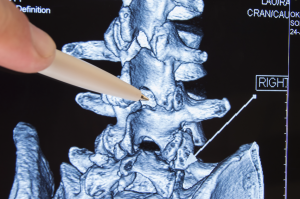Epidural Steroid Injections
Around 80% of people complain of back pain at some point in their lives. A treatment for pain, an epidural steroid injection takes place in the back. Epidural Steroid Injections can alleviate pain and aid in the diagnoses of back pain. Physicians must determine the cause of back pain in order to prevent the pain from getting worse over time or causing further issues. Do not confuse Epidural Steroid Injections with Sympathetic Nerve Blocks, Radiofrequency Ablations, or Genicular Nerve Blocks.
Anatomy of the Spine
33 bones called vertebrae compose the spine. The spine provides the main support of the body and protects the spinal cord. A thick membrane covers the spinal cord and outside of the membrane lies the epidural space. The epidural space gets injected with an anesthetic and a steroid during an Epidural Steroid Injection. The anesthetic alleviates the patients pain while the steroid reduces inflammation and takes pressure off of the nerve roots. The spine has different regions: Cervical, Thoracic, Lumbar, Sacral, and Coccyx regions.
Potential Candidates for Epidural Steroid Injections
At AOA Orthopedic Specialists, Physical Medicine & Rehabilitation specialists perform Epidural Steroid Injections. A PM&R specialist may administer a Epidural Steroid Injection for a variety of conditions including:
Performing Epidural Steroid Injections
The patient cannot drive themselves to or from the hospital. With the patient’s back exposed, the doctor applies topical anesthesia or injects lidocaine to numb the area. The physicians uses fluoroscope to ensure the correct injection placement for the appropriate nerve roots. Before injecting the steroid, the physician injects contrast dye. Contrast dye allows the surgeon to see the precise needle placement. Injecting an anesthetic and steroid typically resolves all if not most of the pain. The anesthetic gets rid of the pain while the steroid decreases inflammation and takes pressure off of the nerve root.
An outpatient procedure, the patient can go home the same day. Patients typically feel immediate pain relief following the procedure. A physician can perform an Epidural Steroid Injection multiple times a year if the pain relief does not last long enough for the patient.
Risks Associated with Epidural Injections
All procedures have potential risks or complications. The risks associated with Epidural Steroid Injections include:
- Temporary numbness of the bladder and or bowels
- Infection
- Dural Puncture- A dural puncture may occur in .5% of injections. A dural puncture does not typically require treatment; however, in certain cases a doctor may have to draw blood from the arm and inject the blood into the epidural space. The blood clots around the spinal sac and stops the leak.
- Bleeding
- Nerve Damage


